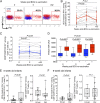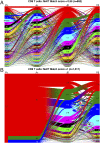MR1-Independent Activation of Human Mucosal-Associated Invariant T Cells by Mycobacteria
- PMID: 31611259
- PMCID: PMC6859375
- DOI: 10.4049/jimmunol.1900674
MR1-Independent Activation of Human Mucosal-Associated Invariant T Cells by Mycobacteria
Abstract
Tuberculosis (TB) is the leading cause of mortality from a single infectious agent, Mycobacterium tuberculosis Relevant immune targets of the partially efficacious TB vaccine bacille Calmette-Guérin (BCG) remain poorly defined. Mucosal-associated invariant T (MAIT) cells are MHC-related protein 1 (MR1)-restricted T cells, which are reactive against M. tuberculosis, and underexplored as potential TB vaccine targets. We sought to determine whether BCG vaccination activated mycobacteria-specific MAIT cell responses in humans. We analyzed whole blood samples from M. tuberculosis-infected South African adults who were revaccinated with BCG after a six-month course of isoniazid preventative therapy. In vitro BCG stimulation potently induced IFN-γ expression by phenotypic (CD8+CD26+CD161+) MAIT cells, which constituted the majority (75%) of BCG-reactive IFN-γ-producing CD8+ T cells. BCG revaccination transiently expanded peripheral blood frequencies of BCG-reactive IFN-γ+ MAIT cells, which returned to baseline frequencies a year following vaccination. In another cohort of healthy adults who received BCG at birth, 53% of mycobacteria-reactive-activated CD8 T cells expressed CDR3α TCRs, previously reported as MAIT TCRs, expressing the canonical TRAV1-2-TRAJ33 MAIT TCRα rearrangement. CD26 and CD161 coexpression correlated with TRAV1-2+CD161+ phenotype more accurately in CD8+ than CD4-CD8- MAIT cells. Interestingly, BCG-induced IFN-γ expression by MAIT cells in vitro was mediated by the innate cytokines IL-12 and IL-18 more than MR1-induced TCR signaling, suggesting TCR-independent activation. Collectively, the data suggest that activation of blood MAIT cells by innate inflammatory cytokines is a major mechanism of responsiveness to vaccination with whole cell vaccines against TB or in vitro stimulation with mycobacteria (Clinical trial registration: NCT01119521).
Copyright © 2019 The Authors.
Figures







References
-
- World Health Organization 2017. Global Tuberculosis Report 2017. Available at: http://www.who.int/tb/publications/global_report/gtbr2017_main_text.pdf?....
-
- Mangtani P., Abubakar I., Ariti C., Beynon R., Pimpin L., Fine P. E., Rodrigues L. C., Smith P. G., Lipman M., Whiting P. F., Sterne J. A. 2014. Protection by BCG vaccine against tuberculosis: a systematic review of randomized controlled trials. Clin. Infect. Dis. 58: 470–480. - PubMed
-
- Le Bourhis L., Martin E., Péguillet I., Guihot A., Froux N., Coré M., Lévy E., Dusseaux M., Meyssonnier V., Premel V., et al. 2010. Antimicrobial activity of mucosal-associated invariant T cells. [Published erratum appears in 2010 Nat. Immunol. 11: 969.] Nat. Immunol. 11: 701–708. - PubMed
Publication types
MeSH terms
Substances
Associated data
Grants and funding
LinkOut - more resources
Full Text Sources
Medical
Research Materials
Miscellaneous

